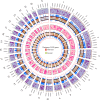Fat-tail allele-specific expression genes may affect fat deposition in tail of sheep
- PMID: 39729475
- PMCID: PMC11676558
- DOI: 10.1371/journal.pone.0316046
Fat-tail allele-specific expression genes may affect fat deposition in tail of sheep
Abstract
Different sheep breeds show distinct phenotypic plasticity in fat deposition in the tails. The genetic background underlying fat deposition in the tail of sheep is complex, multifactorial, and may involve allele-specific expression (ASE) mechanism to modulate allelic expression. ASE is a common phenomenon in mammals and refers to allelic imbalanced expression modified by cis-regulatory genetic variants that can be observed at heterozygous loci. Therefore, regulatory processes behind the fat-tail formation in sheep may be to some extent explained by cis- regulatory variants, through ASE mechanism, which was investigated in the present study. An RNA-Seq-based variant calling was applied to perform genome-wide survey of ASE genes using 45 samples from seven independent studies comparing the transcriptome of fat-tail tissue between fat- and thin-tailed sheep breeds. Using a rigorous computational pipeline, 115 differential ASE genes were identified, which were narrowed down to four genes (LPL, SOD3, TCP1 and LRPAP1) for being detected in at least two studies. Functional analysis revealed that the ASE genes were mainly involved in fat metabolism. Of these, LPL was of greater importance, as 1) observed in five studies, 2) reported as ASE gene in the previous studies and 3) with a known role in fat deposition. Our findings implied that complex physiological traits, like fat-tail formation, can be better explained by considering various genetic mechanisms, which can be more finely mapped through ASE analyses. The insights gained in this study indicate that biallelic expression may not be a common mechanism in sheep fat-tail development. Hence, allelic imbalance of the fat deposition-related genes can be considered a novel layer of information for future research on genetic improvement and increased efficiency in sheep breeding programs.
Copyright: © 2024 Mansourizadeh et al. This is an open access article distributed under the terms of the Creative Commons Attribution License, which permits unrestricted use, distribution, and reproduction in any medium, provided the original author and source are credited.
Conflict of interest statement
The authors have declared that no competing interests exist.
Figures






Similar articles
-
Deep transcriptome analysis using RNA-Seq suggests novel insights into molecular aspects of fat-tail metabolism in sheep.Sci Rep. 2019 Jun 24;9(1):9203. doi: 10.1038/s41598-019-45665-3. Sci Rep. 2019. PMID: 31235755 Free PMC article.
-
Integrated multiomic profiling of tail adipose tissue highlights novel genes, lipids, and metabolites involved in tail fat deposition in sheep.BMC Genomics. 2025 Mar 3;26(1):212. doi: 10.1186/s12864-025-11380-9. BMC Genomics. 2025. PMID: 40033184 Free PMC article.
-
RNA-Seq based genetic variant discovery provides new insights into controlling fat deposition in the tail of sheep.Sci Rep. 2020 Aug 11;10(1):13525. doi: 10.1038/s41598-020-70527-8. Sci Rep. 2020. PMID: 32782325 Free PMC article.
-
Deciphering the role of alternative splicing as a potential regulator in fat-tail development of sheep: a comprehensive RNA-seq based study.Sci Rep. 2024 Jan 29;14(1):2361. doi: 10.1038/s41598-024-52855-1. Sci Rep. 2024. PMID: 38287039 Free PMC article. Review.
-
Trends towards revealing the genetic architecture of sheep tail patterning: Promising genes and investigatory pathways.Anim Genet. 2021 Dec;52(6):799-812. doi: 10.1111/age.13133. Epub 2021 Sep 1. Anim Genet. 2021. PMID: 34472112 Review.
Cited by
-
Decoding the Function of FGFBP1 in Sheep Adipocyte Proliferation and Differentiation.Animals (Basel). 2025 May 18;15(10):1456. doi: 10.3390/ani15101456. Animals (Basel). 2025. PMID: 40427333 Free PMC article.
References
-
- Bruscadin JJ, Cardoso TF, da Silva Diniz WJ, de Souza MM, Afonso J, Vieira D, et al.. Differential Allele-Specific Expression Revealed Functional Variants and Candidate Genes Related to Meat Quality Traits in B. indicus Muscle. Genes (Basel). 2022;13: 2336. doi: 10.3390/genes13122336 - DOI - PMC - PubMed
MeSH terms
LinkOut - more resources
Full Text Sources
Miscellaneous

